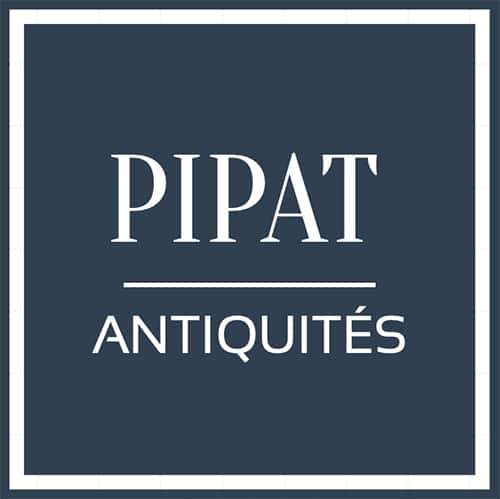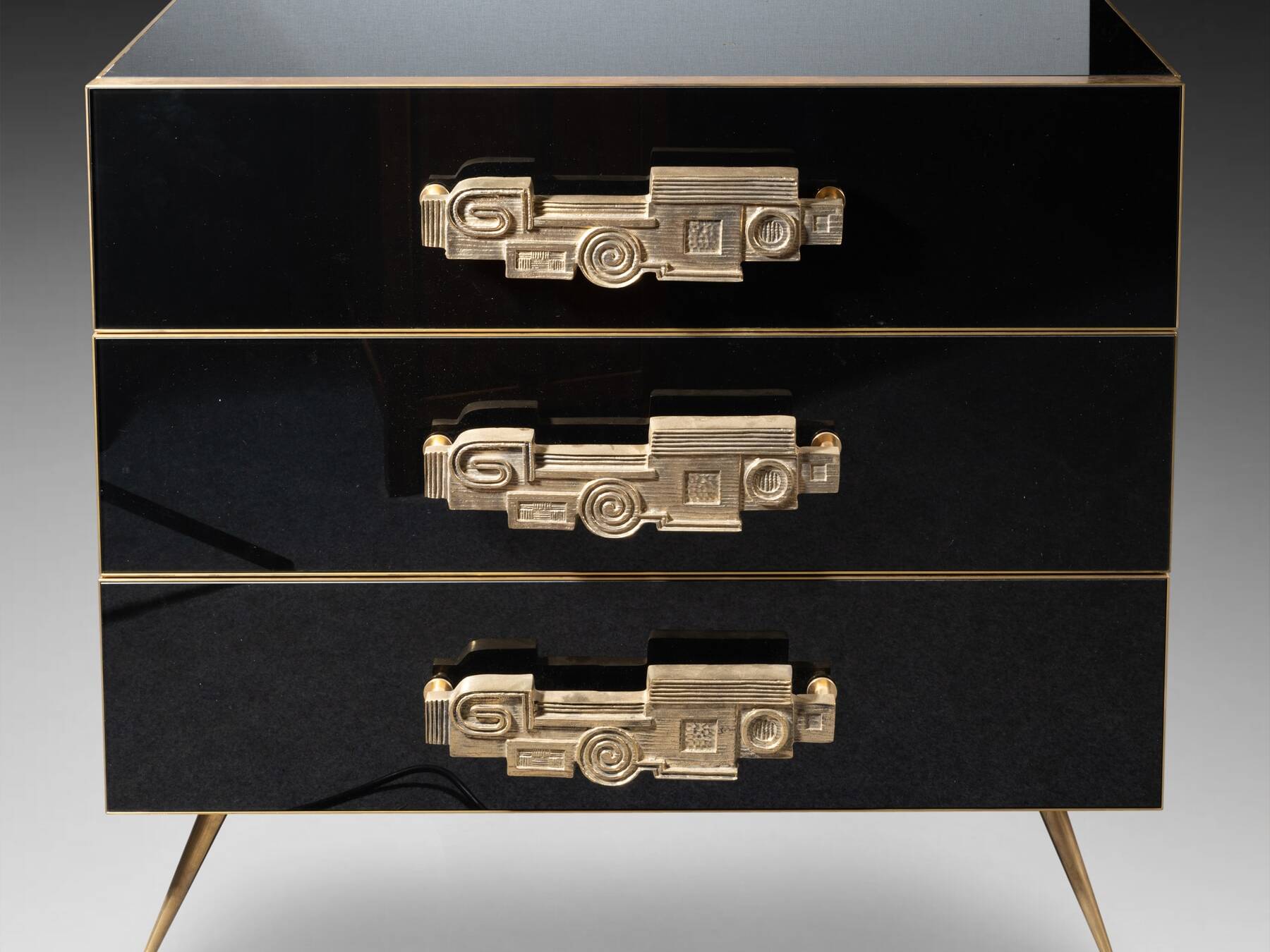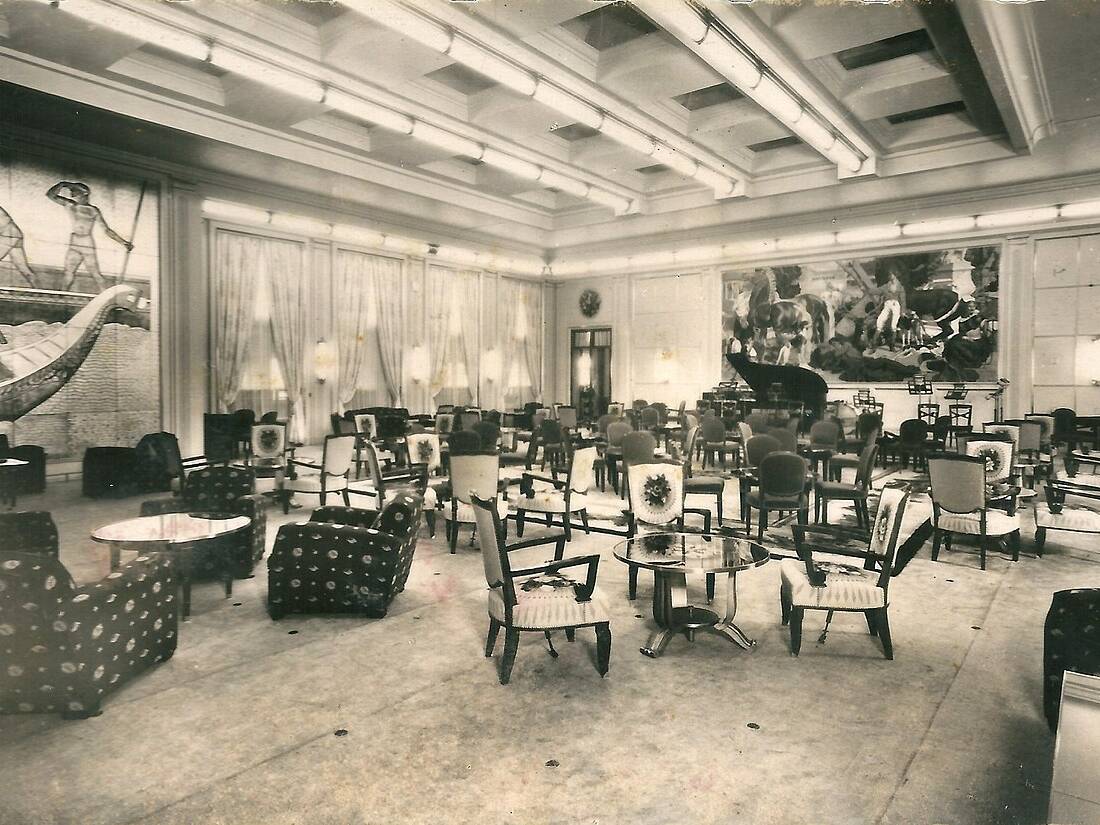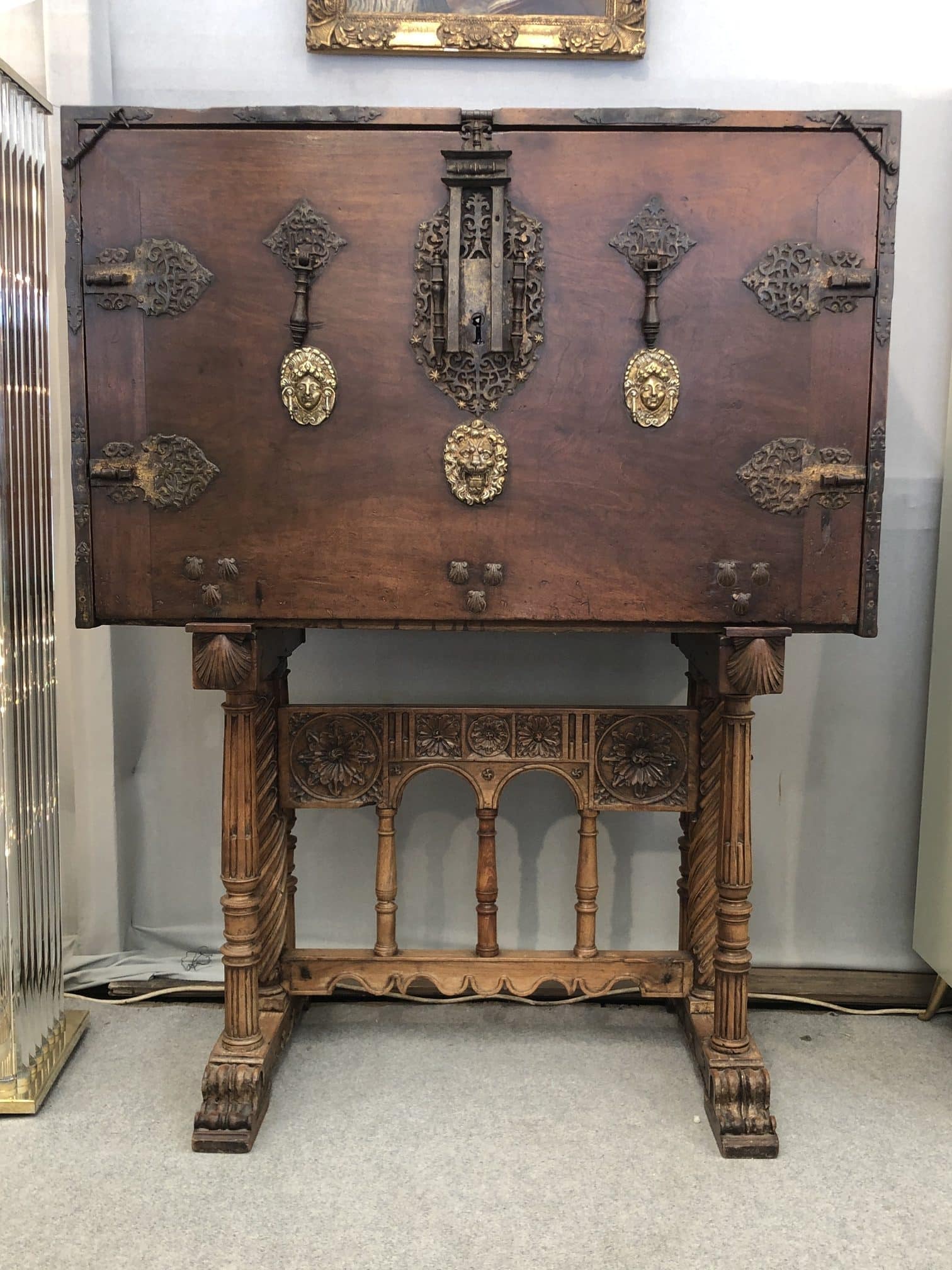
Characteristics of the Spanish bargueño: writing desk, drawers, secrets and base
Traditionally, this imposing cabinet is specially fitted out to be easily used as a writing desk or as a changing table. This is also what earned it its original name of escritorio. Its denomination under the term bargueño or vargueño was not used for the first time until late in the 19th century since its first occurrence appeared in 1872 in the Catalog of Spanish Artistic Objects presented by the Victoria & Albert Museum, in England. The term will then be admitted by the Spanish Real Academia de Lingua in 1914.
This word, which is unanimous today, no doubt refers to the main center of production of this furniture located in the 16th and 17th centuries in Bargas or Vargas (if the spelling of this second toponym differs slightly from the first, its pronunciation remains identical), near Toledo.
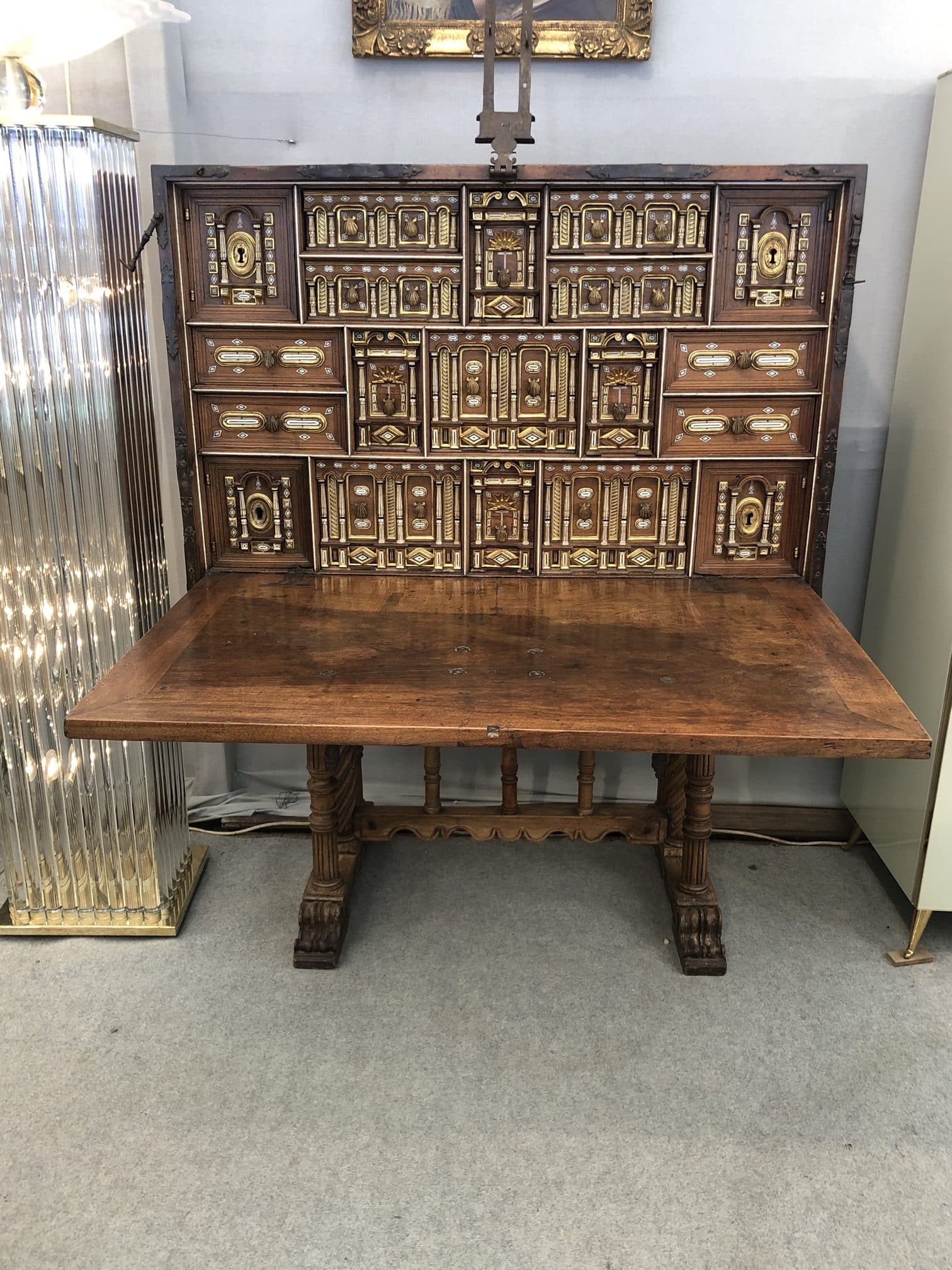
Undoubtedly, the Spanish bargueño is an original and notable contribution to European furniture. Its use is undeniably linked to travel, administration and commerce. The multitude of small drawers is often complemented by secrets, as is the case with the one we are presenting. Here, each drawer has a secret, thus multiplying the storage and uses intended for storing supplies and papers or for hiding more precious goods such as monetary values or, why not, jewellery. For these reasons, this typically Spanish cabinet is equipped with solid metal hinges whose elegant carving further enhances the whole by its decorative qualities and certainly secures the cabinet with a lock similar to a hasp system.
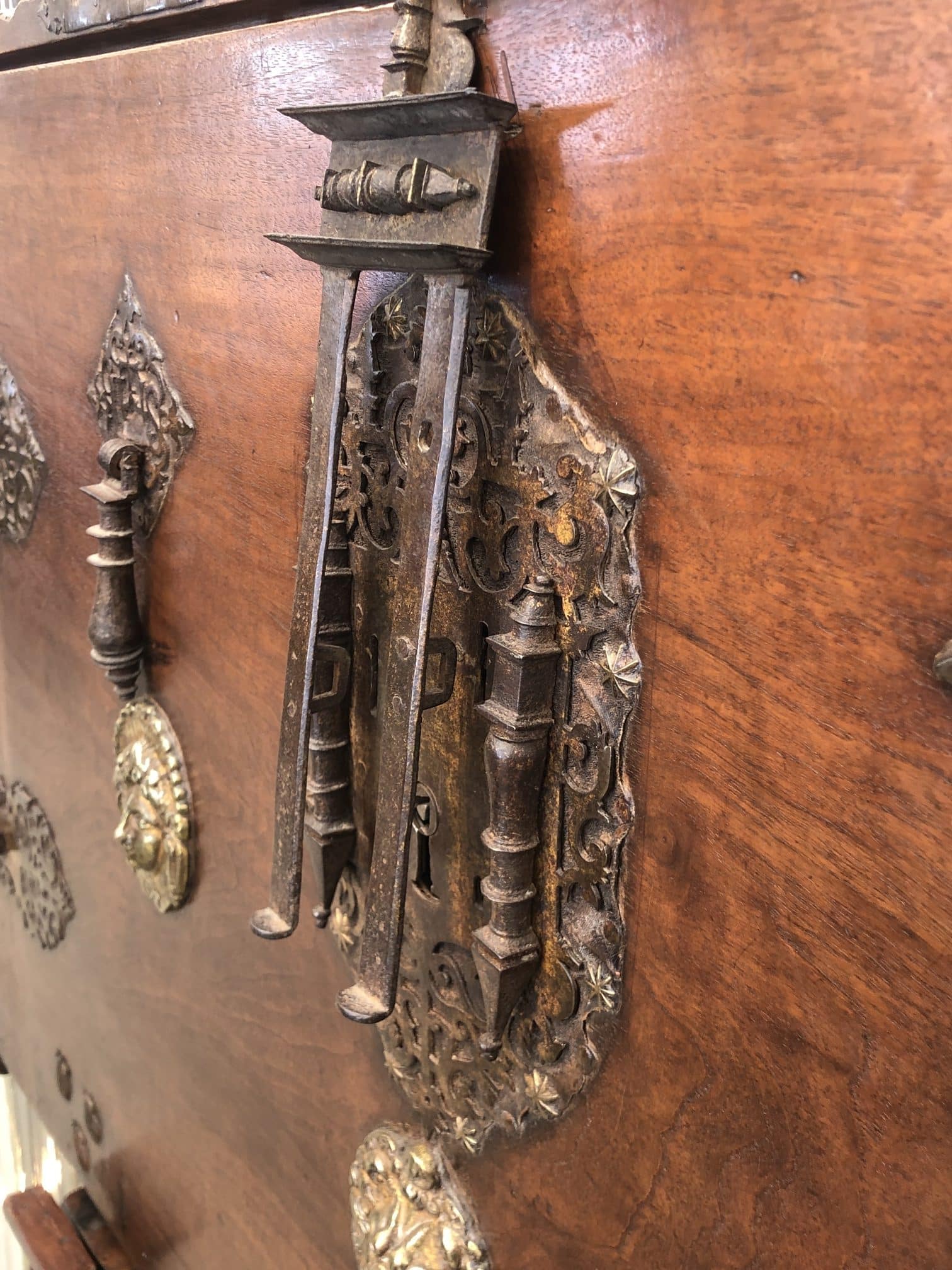
The classic bargueño can rest on two forms of base. The so-called tarte de puente adopts the form of a small table with trestles or trestles while the more elegant form of the base pie de puente is presented as a beautiful arcature, like that of a bridge, with nicely cut shapes and which are not without evoking Mudejar architecture and decorative arts here.
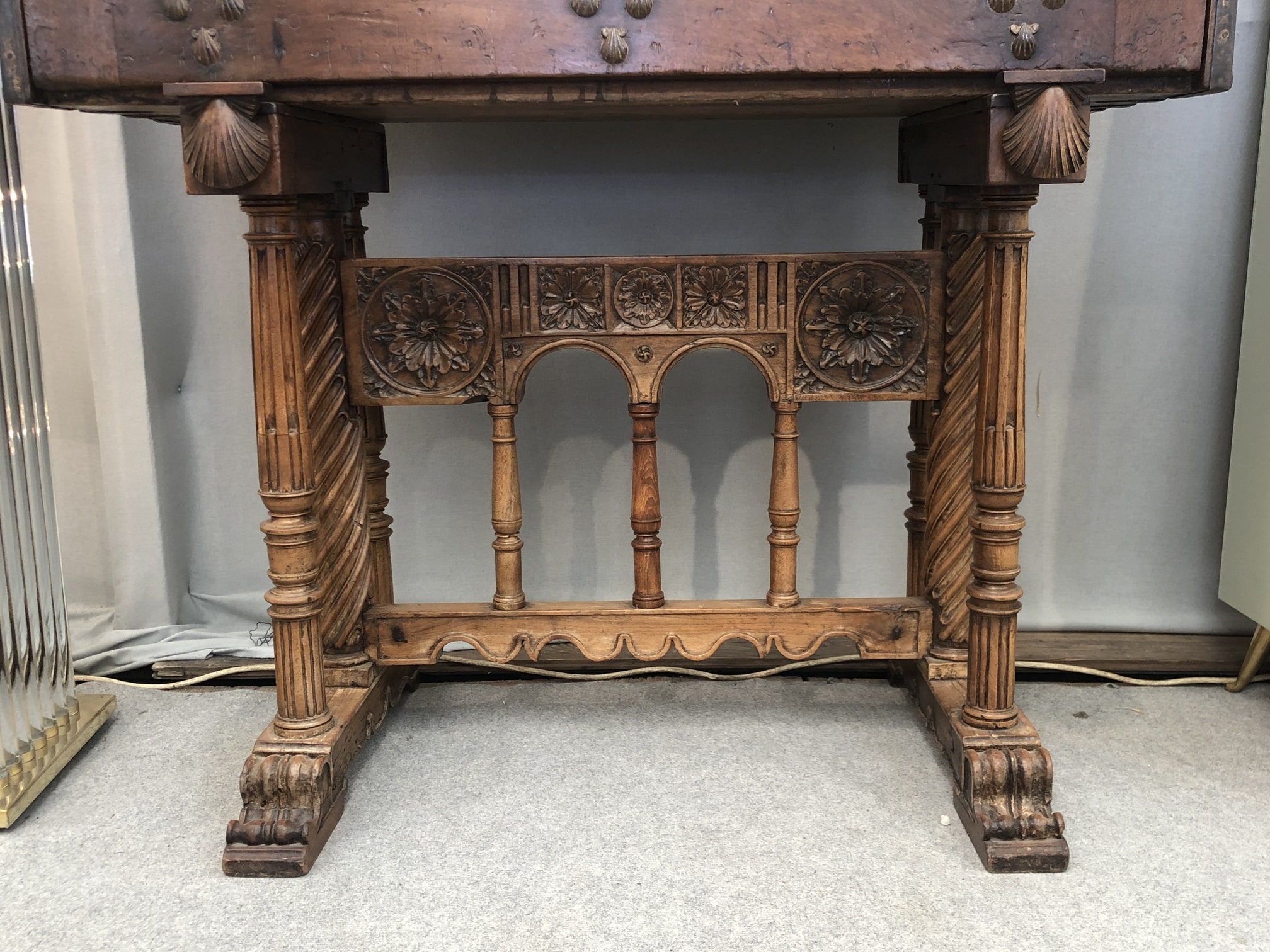
Bargueño or Vargueño: symbolism of monograms and scallops
Monograms
Two monograms are carved into the ironwork adorning our bargueño when it is closed. We read on the left IHS and on the right a crowned MA. The first, well known, is no difficulty: it is the monogram of Christ in the form of an abbreviation and an imperfect transliteration of the name “Jesus” in Greek.
The crowned MA monogram is less common on French furniture or decorative arts but very popular in Spain. It inscribes the Ave Maria or the Auspice Maria as the monogram of the Immaculate Virgin. Under each monogram, a classically styled gold mascaron evokes antique figures.
The two monograms with the central plastron form a trinity whose celestial character can be recognized by the small golden stars. As for the mascaron of the lion with its mouth open in the centre, it is the image of Christ the Redeemer, assimilated to the lion of Judah whose roar symbolizes the divine word, conveniently placed under the lock. Thus, the central motif, the lock and the lion become a metaphor, assimilating the Trinity and the divine word to the key allowing access to the world; and the cabinet key opens then the panel revealing miniature church-like architecture.
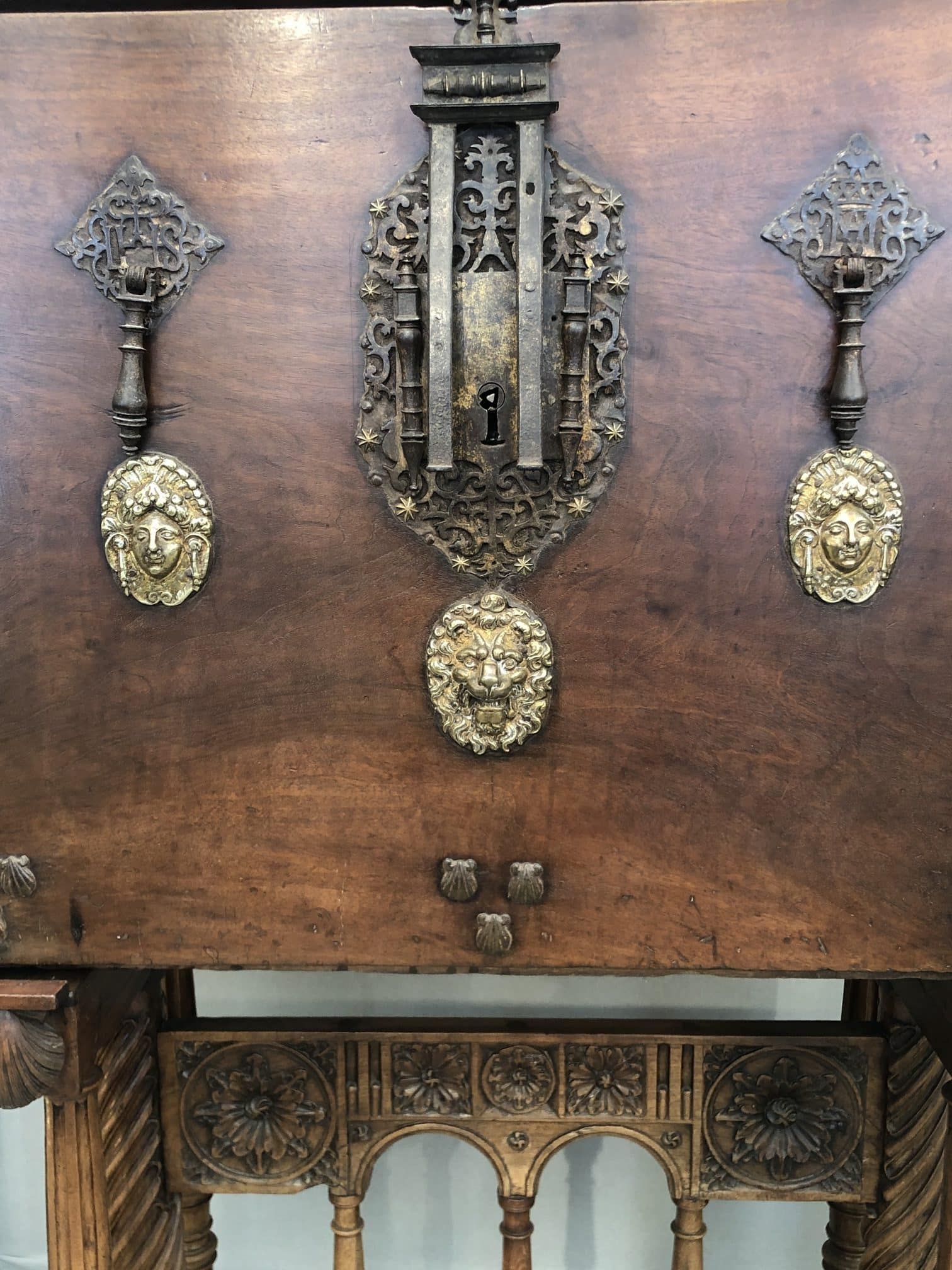
St. Jacques shells
Before opening the bargueño, either pull the two supports towards you to rest the writing table that also forms the closing panel of the cabinet. These two practical elements are cleverly concealed by two sculpted shells, which are like the inverted capitals of the base. Once stretched, they allow the panel to rest without risk.
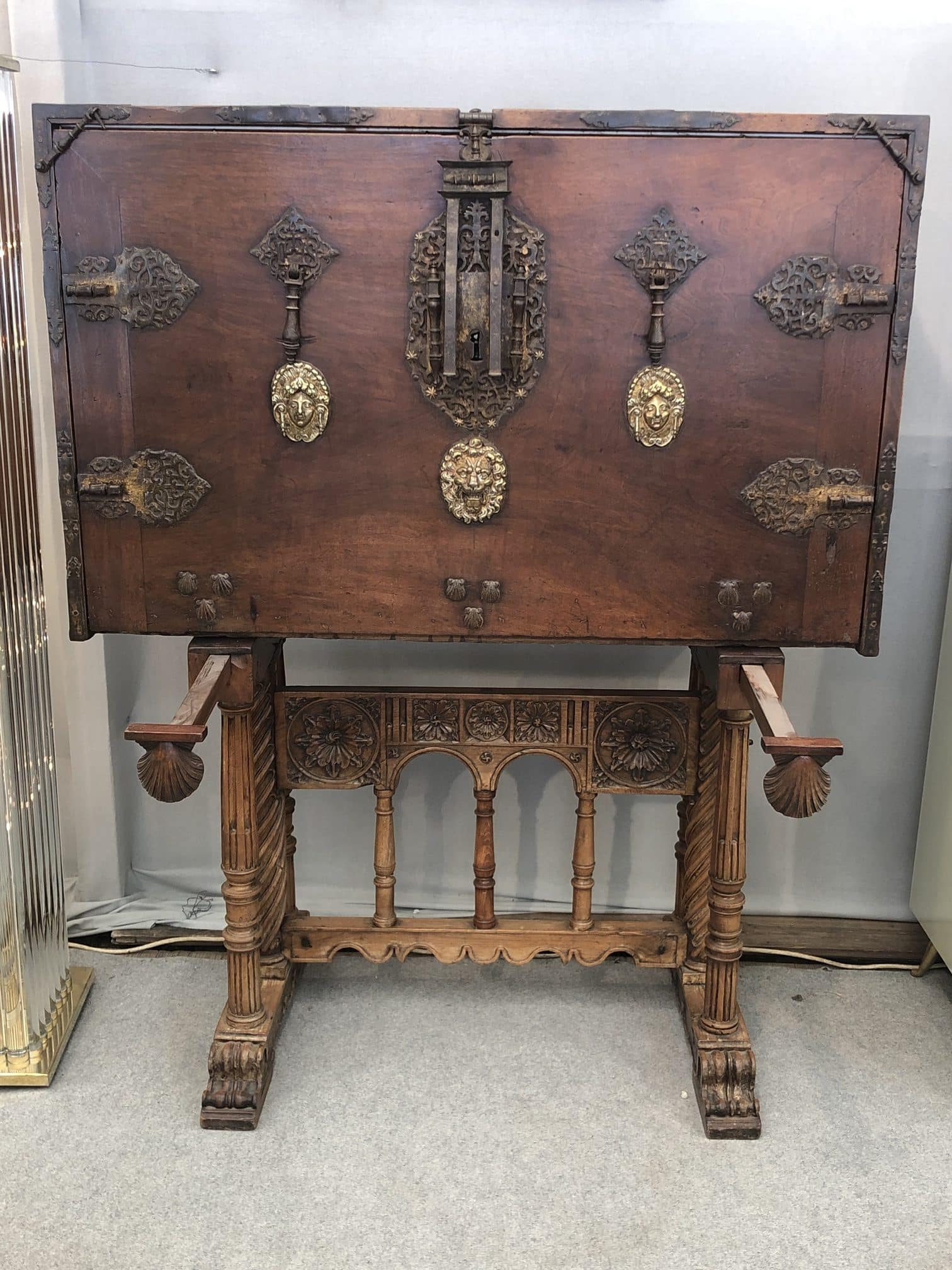
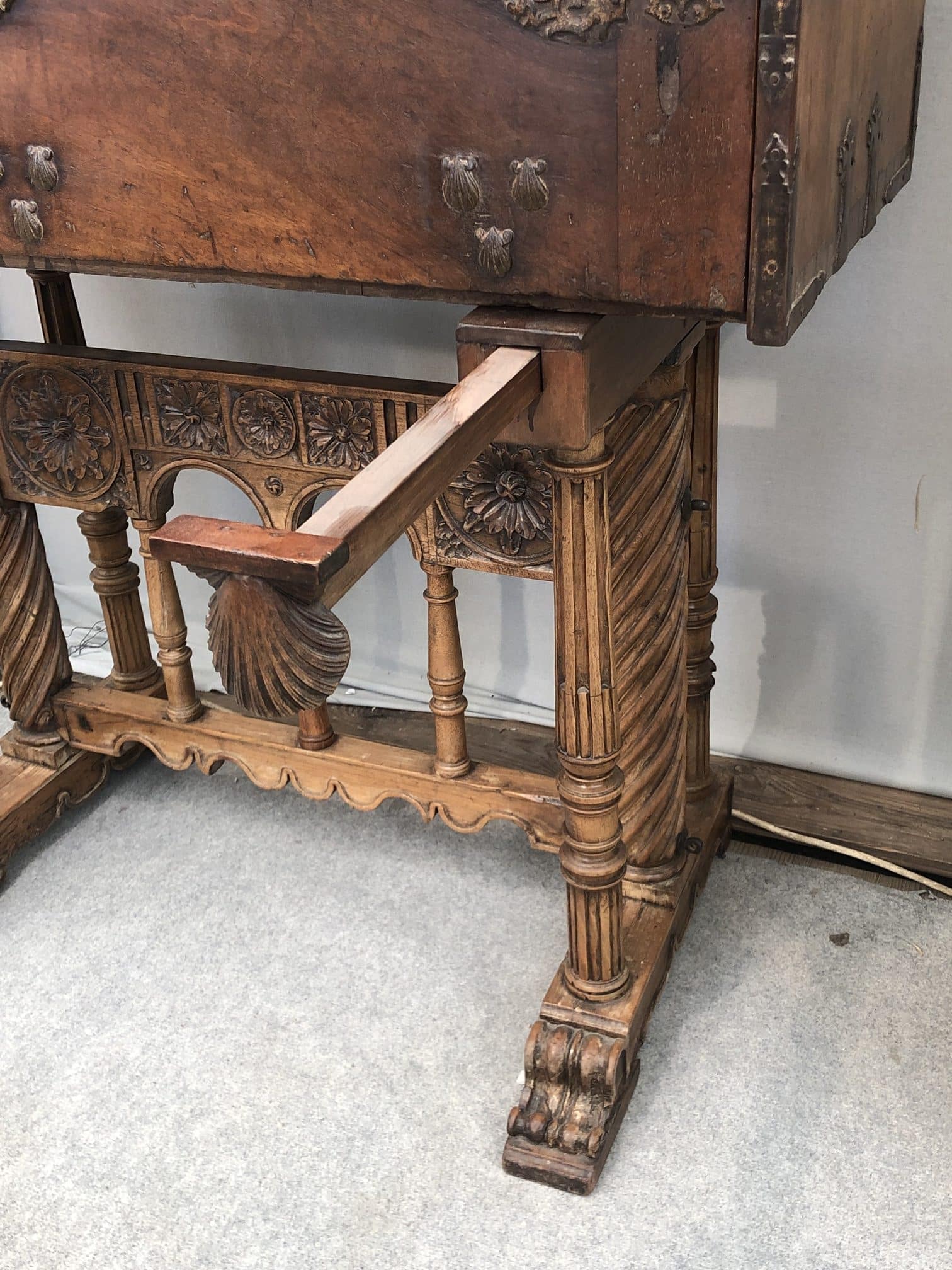
Naturally, the motif of the shell is that of the pilgrimage to Santiago de Compostela that pilgrims used to bring back as testimony to this long and pious journey. The scallops will quickly be a symbol adopted by the religious decorative vocabulary. It could also testify to the piety of the one whom used it, symbolizing the return to the country of a new man, purified by his pilgrimage… Or else going to distant lands with the help of Heaven!
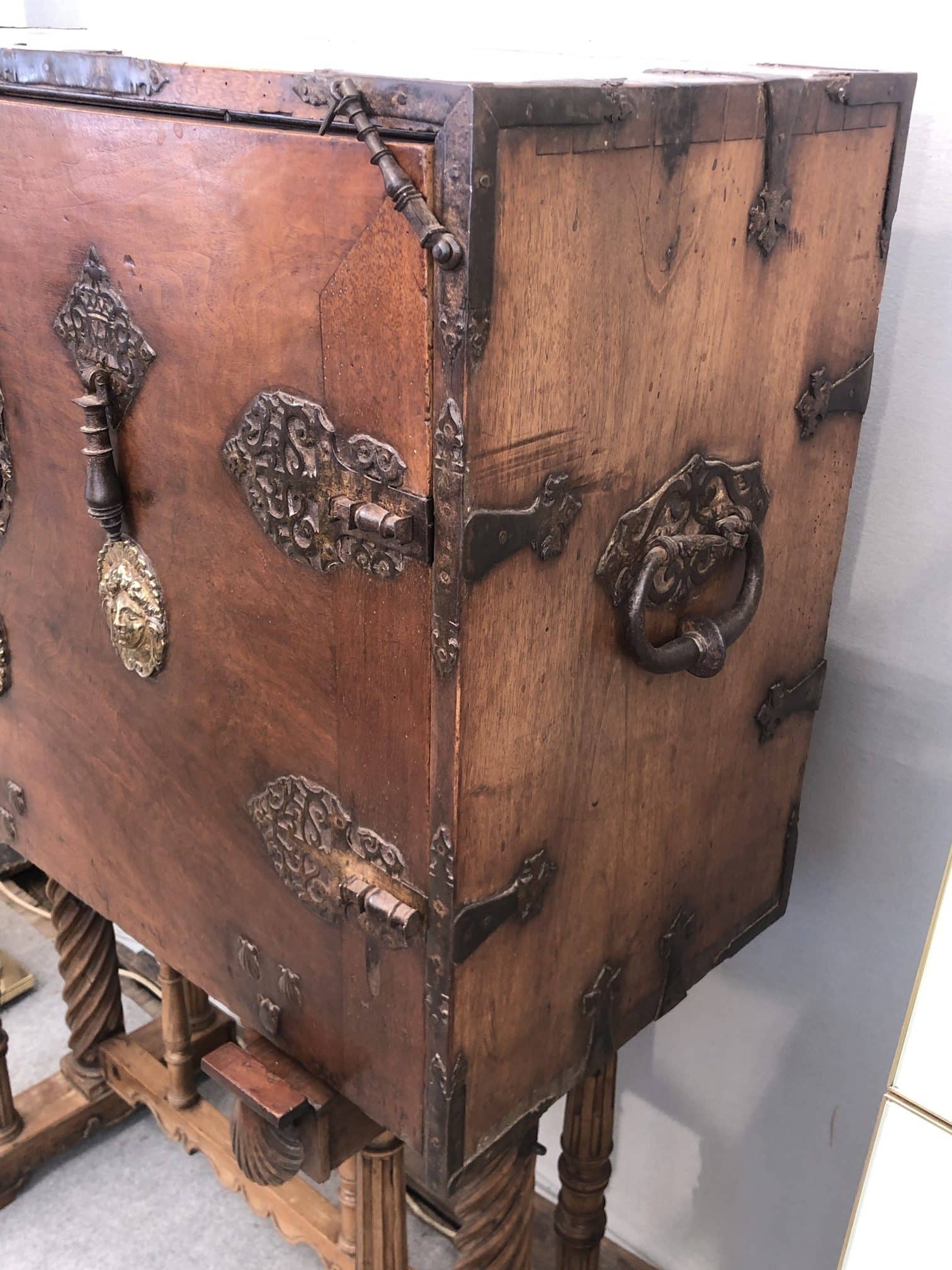
The bargueño indeed quickly distinguished itself as the favorite furniture of missionaries or conquistadores. Easy to move thanks to its side handles, this type of cabinet made it easy to transport administrative, political or diplomatic documents, sometimes personal, during expeditions to the New World or elsewhere. Until the Renaissance, it was the most popular piece of ceremonial furniture in the Iberian Peninsula. When not roaming the roads following its owner, the bargueño was displayed, open, in the most sumptuous public rooms of palaces, castles and other aristocratic residences.

Inside, the sumptuous woodwork decor alternates patterns of olives, diamonds, small columns and radiant suns and echoes the architecture and decorative tastes of the time. The knobs of each drawer are shells. The whole forms a perfectly symmetrical facade whose artisanal techniques as much as the decorations are the heritage of Mudéjar art, a cultural and artistic imprint which marked Spanish art for a long time.
Influences of Mudéjar art and architecture
The ornamental richness of our cabinet does not have to be ashamed of its oriental influences. The craftsmanship that has made it possible to achieve such finesse owes a lot to the arrival in Spain of the Umayyads and the emergence of the al-Andalus style. The resulting Mudéjar art a few centuries later naturally stems from the paradoxical emulation that accompanies the reconquest by Christian armies of territories occupied by the Arabs. Authorized to practice their profession despite the change of power, Muslim master craftsmen gradually developed a new style called Mudéjar, and defined today as a Christian art influenced by earlier Muslim art in reconquered Spain.
In this art, which is expressed both through architecture and the decorative arts, we frequently find ornate metal hinges, work in bone, ivory and mother-of-pearl – grouped together under the term tabletterie – a decoration made of floral or geometric patterns (diamonds, stars, checkerboards, circles, etc.) fine and affixed in a repetitive way to cover immense surfaces.
The architectures and objects thus adorned are transformed into sumptuous ceremonial works of remarkable meticulousness. Horror vacui reigns supreme, like a memory of the intertwined and refined patterns of Islamic stucco.
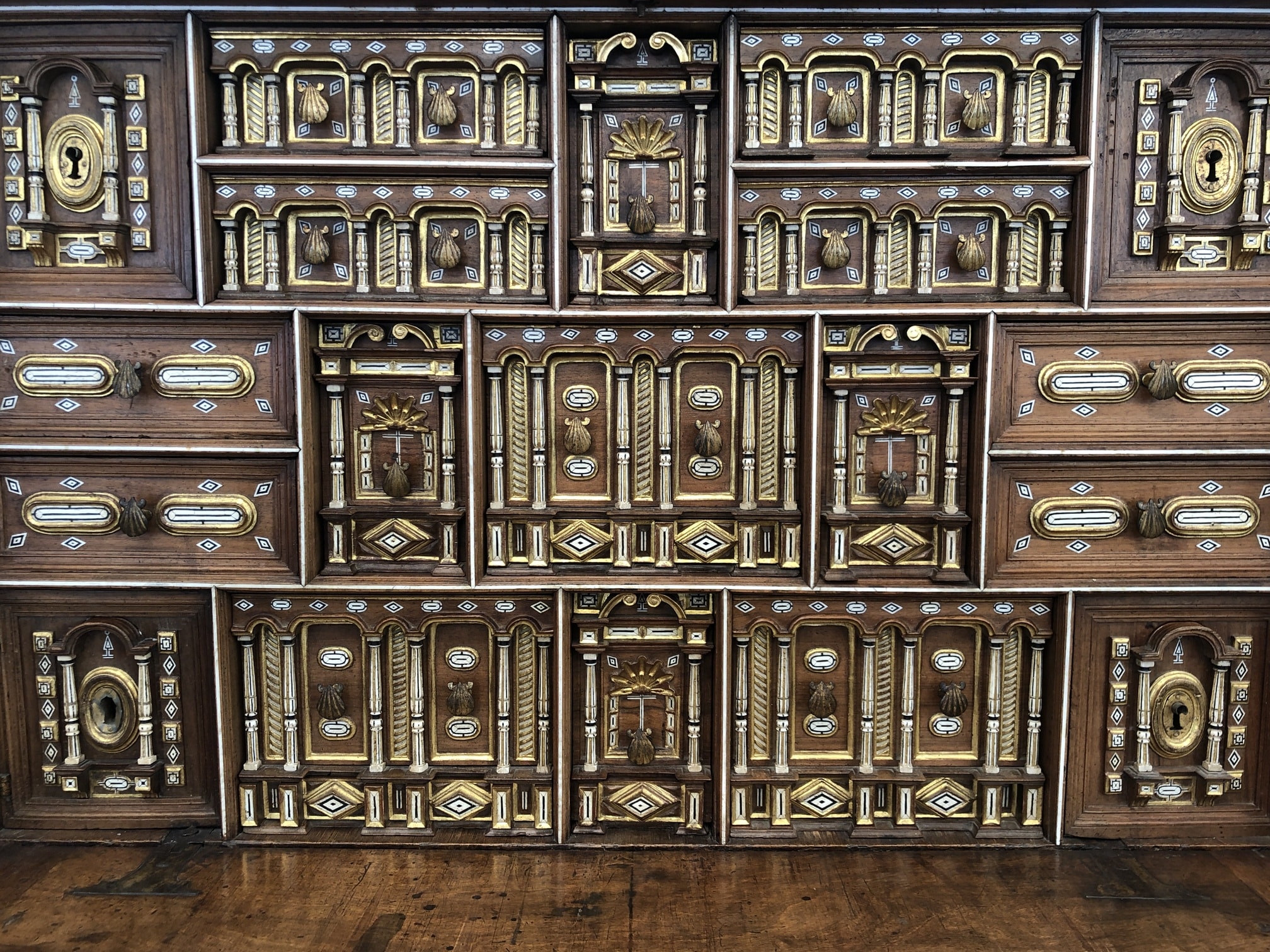
This new language common to Christians and Muslims will penetrate Hispanic culture so well that it will become synonymous with Spanish hegemony abroad. Evidenced by the architecture of South America and Central America, regularly described as Mudéjar. The phenomenon is also evident in the decorative arts and furniture. This 17th century bargueño is a living illustration of this.
Delicately combining tabletterie, woodwork and ironwork, this bargueño reveals, on closer inspection, a whole section of the artistic history of Spain. From the craftsmanship mastered and imported to the peninsula by the Umayyads, their appropriation by indigenous craftsmen to the slow evolution of patterns and techniques towards an art entirely dedicated to aristocratic and Catholic power, our bargueño is much more than a piece of furniture emblematic of Spain. It is, all by itself, the witness of cultural exchanges and upheavals of the great History.
Marielle Brie
Art Historian for Art Market and Cultural Media
Author of the blog Objets d’Art et d’Histoire
Autres ressources et documentations
28 June 2025
Plaster Sculptures, Plaster Casts
For a long time, plaster casts suffered from a poor reputation. Often regarded as crude replicas, and sometimes even dismissed as inexpensive imitations, they nonetheless had…
17 April 2025
The Middle-Ages Furniture
Rare and highly sought-after, Middle-Ages furniture is making a strong comeback. An overview of this market, where enlisting the guidance of a professional is strongly advisable.
18 March 2025
Murano Glass Furniture
Since the beginning of the 20th century, Murano glassmakers have been exploring new horizons. After classic lighting and decorative art, Murano glass is now used to adorn…
16 December 2024
A bronze triton after the sculptures of François Girardon (1628 – 1715) in Versailles
This fountain element is all the more admirable as it is sculpted after the masterpieces of the Pyramid Basin, on the parterre of the North Wing of the Versailles gardens.
18 November 2024
Tyco Bookcase, by Manfredo Massironi, for Nikol International
A pure creation of optical art research in the 1960s, the Tyco library shelf designed by Manfredo Massironi invites the viewer to bring the work of art to life on a daily basis.
3 August 2024
The Ocean Liner Style
In the 20th century, the immense ocean liners connecting the Old Continent and the New World were ambassadors of tastes and innovations on both sides of the Atlantic.
